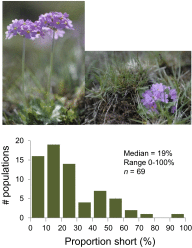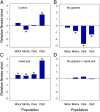Mutualists and antagonists drive among-population variation in selection and evolution of floral display in a perennial herb
- PMID: 24145439
- PMCID: PMC3831491
- DOI: 10.1073/pnas.1301421110
Mutualists and antagonists drive among-population variation in selection and evolution of floral display in a perennial herb
Abstract
Spatial variation in the direction of selection drives the evolution of adaptive differentiation. However, few experimental studies have examined the relative importance of different environmental factors for variation in selection and evolutionary trajectories in natural populations. Here, we combine 8 y of observational data and field experiments to assess the relative importance of mutualistic and antagonistic interactions for spatial variation in selection and short-term evolution of a genetically based floral display dimorphism in the short-lived perennial herb Primula farinosa. Natural populations of this species include two floral morphs: long-scaped plants that present their flowers well above the ground and short-scaped plants with flowers positioned close to the ground. The direction and magnitude of selection on scape morph varied among populations, and so did the frequency of the short morph (median 19%, range 0-100%; n = 69 populations). A field experiment replicated at four sites demonstrated that variation in the strength of interactions with grazers and pollinators were responsible for among-population differences in relative fitness of the two morphs. Selection exerted by grazers favored the short-scaped morph, whereas pollinator-mediated selection favored the long-scaped morph. Moreover, variation in selection among natural populations was associated with differences in morph frequency change, and the experimental removal of grazers at nine sites significantly reduced the frequency of the short-scaped morph over 8 y. The results demonstrate that spatial variation in intensity of grazing and pollination produces a selection mosaic, and that changes in biotic interactions can trigger rapid genetic changes in natural plant populations.
Keywords: adaptive evolution; divergent selection; floral trait; herbivory; natural selection.
Conflict of interest statement
The authors declare no conflict of interest.
Figures





References
-
- Thompson JN. The Coevolutionary Process. Chicago: Univ Chicago Press; 1994.
-
- Thompson JN. The Geographic Mosaic of Coevolution. Chicago: Univ Chicago Press; 2005.
-
- Schluter D. The Ecology of Adaptive Radiation. Oxford, UK: Oxford Univ Press; 2000.
-
- Mitchell-Olds T, Willis JH, Goldstein DB. Which evolutionary processes influence natural genetic variation for phenotypic traits? Nat Rev Genet. 2007;8(11):845–856. - PubMed
-
- Marquis RJ. The selective impact of herbivores. In: Fritz RS, Simms EL, editors. Plant Resistance to Herbivores and Pathogens. Chicago: Univ Chicago Press; 1992. pp. 301–325.
Publication types
MeSH terms
LinkOut - more resources
Full Text Sources
Other Literature Sources

